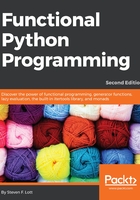
Familiar territory
One of the ideas that emerged from the previous list of topics is that most functional programming is already present in Python. Indeed, most functional programming is already a very typical and common part of OOP.
As a very specific example, a fluent Application Program Interface (API) is a very clear example of functional programming. If we take time to create a class with return self() in each method function, we can use it as follows:
some_object.foo().bar().yet_more()
We can just as easily write several closely related functions that work as follows:
yet_more(bar(foo(some_object)))
We've switched the syntax from traditional object-oriented suffix notation to a more functional prefix notation. Python uses both notations freely, often using a prefix version of a special method name. For example, the len() function is generally implemented by the __len__() class special method.
Of course, the implementation of the preceding class might involve a highly stateful object. Even then, a small change in viewpoint may reveal a functional approach that can lead to more succinct or more expressive programming.
The point is not that imperative programming is broken in some way, or that functional programming offers a vastly superior technology. The point is that functional programming leads to a change in viewpoint that can, in many cases, be helpful for designing succinct, expressive programs.